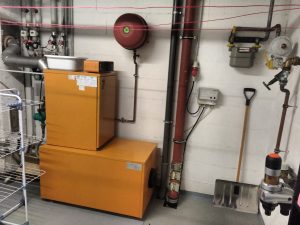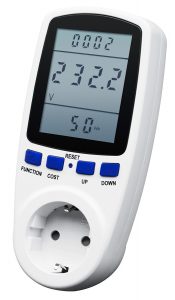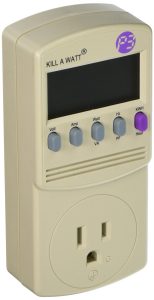
- water
- cold water (not really sure the difference)
- hotwater upstairs (we’re in a 2 story flat)
- hotwater downstairs
- heating
- natural gas
- electricity
What’s warm rent?
In the US, your rent and utilities are separate. Here, they’re separate too, but the accounting is different. When you pay rent, you pay an additional amount to the landlord to cover heating, water, garbage. The amount you pay is initially a guess, based on the previous occupant 1. At the end of the year, you read the meters and adjust2 Kinda like taxes. Electricity is the same, except it’s all between you and the electric company. I didn’t realize the end of year accounting is the same until I got the adjustment sheet a week or two ago. That explained why on the one hand they were deducting from my bank account but on the other, “…why haven’t I been getting a bill?” So the bill. It’s unclear how much the adjustment was, but it’s about 100euros. More interesting is the actual numbers involved.What’s a kilowatt hour?
How many of you know how many kilowatt hours you use? Do you know what a kilowatt hour is? Most of my friends are engineers, so perhaps some of them do. When you hear about Megawatt generators, Gigawatt… does that mean anything to you? When you see a modern wind turbine, how much do those produce? According to wikipedia:3According to the readings at my apartment, we used 1779kWh of electricity in 255 days. This trends to 2756kWh for a year. The paper from the electric company also gave some statistics for typical usage and our usage lies between the typical 1 person (1960) and 2 person (3523) household. I don’t see how our usage could be below typical.Typical modern wind turbines have diameters of 40 to 90 metres (130 to 300 ft) and are rated between 500 kW and 2 MW. As of 2014 the most powerful turbine, the Vestas V-164, is rated at 8 MW and has a rotor diameter of 164m.
- Someone’s always home
- We cook everyday (electric oven/cooktop)
- 2 kids generate LOTS of laundry
 Similar to the one I have in Portland:
Similar to the one I have in Portland:
 Our usage is just over 7kWh/day. The break down as I’ve computed it so far:
Our usage is just over 7kWh/day. The break down as I’ve computed it so far:- My Skylake computer is always on and idles at 38W. Just under a kWh. Pretty significant. 4
- To wash a load of clothes at 30 degrees C (warm) uses .6kWh.
- To dry a load of clothes is 1.1kWh. We probably do one a day on average. Perhaps a little more.
- I can’t use my plug-in meter on the stove/oven, but googling tells me an oven can use 2400 watt/average. I bake something probably twice a week. One of those times is for pizza when it’s on max for one to two hours. I’ll call it .5kWh/day
- The cooktop probably uses 1500 watts. Takes an hour to cook dinner?
- Dishwasher 1.5kWh? we use it everyday.
Comparing it to our usage in Portland
Portland electricity costs about $0.08/kWh. (2756kWh/365day*31days/month*$0.08/kWh)= $18/month. Add $10 for taxes and other stuff and that computation is still way less than what I remember the bill to be. I currently have our house listed on vrbo.com. This time of year, there’s not much going on. Summer is where the money is. We’re happy to have 50% occupancy. This month’s bill is $52.- The house is heated with gas
- The stove is gas
- The dryer is gas
- We have a freezer and and old fridge in the basement
- Everything is lighted with CFLs
- It is about twice the size of our apartment here
Follow up
In my post about German apartments, I talked about how you have to provide your own lighting fixtures. I also learned this summer that Lithuania goes to the other extreme. Not only do they have light fixtures, most apartments are furnished. Here’s a post that mentions this fact. The way I learned it was when a friend from Portland, Chris, was passing through Frankfurt. I told him about the fixtures thing and he recounted a story where a Lithuanian friend, upon seeing a friend’s new apartment said, “so,…. where’s the furniture?” That’s all the follow up I can think of at the moment. I need to start writing them down.one housing agent I talked to says she ups the amount a little if there are kids involved. More baths, warmer, more time spent at home ↩
I think this is insane. What if you spring a water leak (for example the toilet flap gets old). This can make your bill jump to $1000. Imagine if the meter were only read once a year! In Portland most of the electric meters are read by radio by a truck driving through the neighborhood. Portland water is read once a quarter. They tried electronic water meters, but being in the ground, they’re not reliable. ↩
As an aside. Modern windmills are a thing of beauty. Compared to the old ones, I’d call them majestic. My mom and I were once driving through the German countryside and saw one right off the side of the road. So we stopped the car and walked up to it. The base had a larger footprint than most people’s Tuffsheds. Closer to the size of a normal kitchen. It was very quiet. When one of the rotors came by I just hear a soft “wump”. Maybe one a second, one would come by. In parts of the US, people resist the installation of more of these. I don’t understand why.↩
I’ve been meaning to have it auto sleep when not in use. Since I run Plex on it, that’s a little complicated, though we really only watch TV during certain hours. I also want it to be available for auto-photo upload from my phone. I need to get on it. ↩
We have LED everywhere. ↩